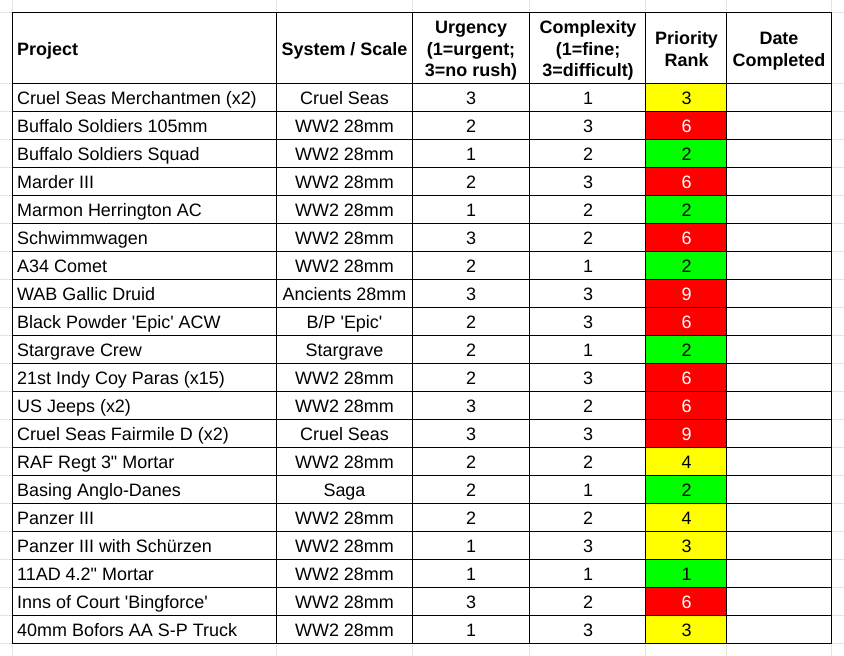Prioritising Painting Projects
Hello, Gaming Friends! Those of you who've read some of my posts for WS&S over the last year might have worked out that I often spend far more time thinking about tabletop wargaming than I do actually painting or playing. Inevitably, this is mostly due to family, house, and work commitments, but it means that rather than rolling dice or painting, I often have to make do with day-dreaming about my hobby in snatched moments. Plotting and planning. And I make a lot of notes - either in my hobby notebook when I'm at home or on miscellaneous scraps of paper when I'm not. Today I'd like to introduce you to one of the tools I often use whilst plotting and planning: I prioritise my hobby 'to-do list'. It's a simple system which lives in my notebook, but for the purposes of clarity here, I've copied it across onto a simple spreadsheet. Essentially, when trying to prioritise my billions of hobby projects, I use two variables for each project, each ranking from 1 - 3. Here's what it looks like; a fuller explanation follows:
The values of the two variables are then multiplied together to give a 'priority rank': the lower the number, the more I ought to prioritise that project's completion. In theory. I don't know the name for this kind of system, but I picked it up from undertaking a health and safety audit of a building years ago.
---
The first variable is 'urgency'. Urgency takes into account such factors as- the unit's general utility within its force,
- whether it's needed for any upcoing events or special scenarios, and
- getting it out of my 'to-do' drawer [I don't have dedicated hobby space in my small cottage, so all my stuff lives tucked away in drawers under the shared desk: this includes a drawer dedicated to 'works-in-progress' which is - of course - always full to bursting!].
---
The second variable is 'complexity'. Complexity takes into account more obvious factors, such as- How intrinsically awkward or time-consuming the painting progress will be (for example, camouflage smocks, 'dazzle'-painted ships or Caunter schemes),
- Additional levels of awkwardness such as basing or applying decals, and
- How convenient actually accessing the model is: if it's in my 'to-do' drawer, then fine; if it's buried unbuilt in a box in the shed - less so.
---
For those of you who enjoy such things, I also took the chance to try colour-coding those priorities, with green being high- and red being low-priority:
Maybe those colours would be better the other way round? Either way, all of this spreadsheet play has a real-world application too, for as I problem-solve 'Google Sheets' in my hobby time, I genuinely improve my real-world IT skills! Of course, I know all this isn't for everyone and it's way too needlessly complicated for some, but then, as I say: I spend a lot of time just thinking about my hobby, so for me at least, it's helpful to attack it efficiently when I do actually get the chance. - Chris.


